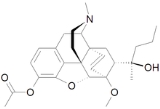
Acetorphine
Encyclopedia
Acetorphine is a potent analgesic
drug, up to 8700 times stronger than morphine
by weight. It is a derivative
of the more well-known opioid etorphine
, which is used as a very potent veterinary painkiller and anesthetic medication, primarily for the sedation of large animals such as elephants, giraffes and rhinos.
Acetorphine was developed in 1966 by the Reckitt research group that developed etorphine. Acetorphine was developed for the same purpose as etorphine itself, namely as a strong tranquilizer for use in immobilizing large animals in veterinary medicine. Despite showing some advantages over etorphine, for instance producing less toxic side effects in giraffes, acetorphine was never widely adopted for veterinary use, and etorphine (along with other tranquilizers such as carfentanil
and azaperone
) remains the drug of choice in this application.
Acetorphine is a Schedule I controlled substance in the United States. Its DEA Administrative Controlled Substances Control Number is 9319 and the one salt in use, acetorphine hydrochloride, has a freebase conversion ratio of 0.93
Analgesic
An analgesic is any member of the group of drugs used to relieve pain . The word analgesic derives from Greek an- and algos ....
drug, up to 8700 times stronger than morphine
Morphine
Morphine is a potent opiate analgesic medication and is considered to be the prototypical opioid. It was first isolated in 1804 by Friedrich Sertürner, first distributed by same in 1817, and first commercially sold by Merck in 1827, which at the time was a single small chemists' shop. It was more...
by weight. It is a derivative
Derivative (chemistry)
In chemistry, a derivative is a compound that is derived from a similar compound by some chemical or physical process. In the past it was also used to mean a compound that can be imagined to arise from another compound, if one atom is replaced with another atom or group of atoms, but modern...
of the more well-known opioid etorphine
Etorphine
Etorphine is a semi-synthetic opioid possessing an analgesic potency approximately 200 times that of morphine. It was first prepared in 1960 from oripavine, which does not generally occur in opium poppy extract but rather in "poppy straw" and in related plants, Papaver orientale and Papaver...
, which is used as a very potent veterinary painkiller and anesthetic medication, primarily for the sedation of large animals such as elephants, giraffes and rhinos.
Acetorphine was developed in 1966 by the Reckitt research group that developed etorphine. Acetorphine was developed for the same purpose as etorphine itself, namely as a strong tranquilizer for use in immobilizing large animals in veterinary medicine. Despite showing some advantages over etorphine, for instance producing less toxic side effects in giraffes, acetorphine was never widely adopted for veterinary use, and etorphine (along with other tranquilizers such as carfentanil
Carfentanil
Carfentanil or carfentanyl is an analogue of the popular synthetic opioid analgesic fentanyl, and is one of the most potent opioids known . Carfentanil was first synthesized in 1974 by a team of chemists at Janssen Pharmaceutica which included Paul Janssen...
and azaperone
Azaperone
Azaperone is a pyridinylpiperazine and butyrophenone neuroleptic drug with sedative and antiemetic effects, which is used mainly as a tranquilizer in veterinary medicine. It is used mainly in pigs and elephants. More rarely it may be used in humans as an antipsychotic drug, but this is uncommon...
) remains the drug of choice in this application.
Acetorphine is a Schedule I controlled substance in the United States. Its DEA Administrative Controlled Substances Control Number is 9319 and the one salt in use, acetorphine hydrochloride, has a freebase conversion ratio of 0.93

